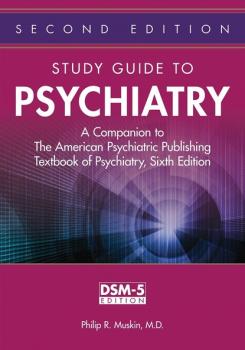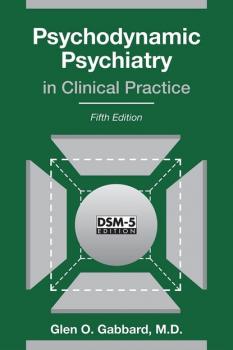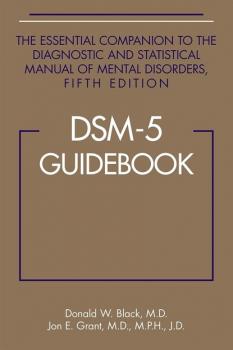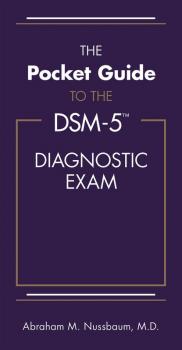ТОП просматриваемых книг сайта:
Психотерапия и консультирование
Различные книги в жанре Психотерапия и консультирование, доступные для чтения и скачиванияАннотация
Study Guide to Psychiatry is a question-and-answer companion that allows you to evaluate your mastery of the subject matter as you progress through The American Psychiatric Publishing Textbook of Psychiatry, Sixth Edition. The Study Guide is made up of approximately 500 questions divided into 38 individual quizzes of 10–20 questions each that correspond to the chapters in the Textbook. Questions are followed by an Answer Guide that references relevant text (including the page number) in the Textbook to allow quick access to important information. Each answer is accompanied by a discussion that addresses the correct response and also (when appropriate) explains why other responses are not correct.The Study Guide's companion, The American Psychiatric Publishing Textbook of Psychiatry, Sixth Edition, has been meticulously revised to maintain its preeminence as an accessible and authoritative training reference and clinical compendium. The first comprehensive psychiatry textbook to integrate the new DSM-5® criteria, this acclaimed gold standard is the definitive guide for a new era in psychiatric education and practice.
Аннотация
It is difficult to improve on a classic, but the fifth edition of Psychodynamic Psychiatry in Clinical Practice does just that, offering the updates readers expect with a deft reorganization that integrates DSM-5® with the author's emphasis on psychodynamic thinking. The individual patient is never sacrificed to the diagnostic category, yet clinicians will find the guidance they need to apply DSM-5® appropriately. Each chapter has been systematically updated to reflect the myriad and manifold changes in the 9 years since the previous edition's publication. All 19 chapters have new references and cutting-edge material that will prepare psychiatrists and residents to treat patients with compassion and skill. The book offers the following features: Each chapter integrates new neurobiological findings with psychodynamic understanding so that clinicians can approach their patients with a truly biopsychosocial treatment plan. Excellent writing and an intuitive structure make complicated psychodynamic concepts easy to understand so that readers can grasp the practical application of theory in everyday practice. The book links clinical understanding to the new DSM-5® nomenclature so that clinicians and trainees can adapt psychodynamic thinking to the new conceptual models of disorders. New coverage of psychodynamic thinking with relation to the treatment of patients on the autism spectrum addresses an increasingly important practice area. Posttraumatic stress and dissociative disorders have been combined to allow for integrated coverage of primary psychiatric disorders related to trauma and stressors. A boon to clinicians in training and practice, the book has been meticulously edited and grounded in the latest research. The author firmly believes that clinicians must not lose the complexities of the person in the process of helping the patient. Psychodynamic Psychiatry in Clinical Practice, Fifth Edition, keeps this approach front and center as it engages, instructs, and exhorts the reader in the thoughtful, humane practice of psychodynamic psychiatry.
Аннотация
Thoroughly and scrupulously updated, the sixth edition of the Introductory Textbook of Psychiatry has been reorganized and rewritten to reflect the reformulated DSM-5® diagnostic classes, rendering all other texts obsolete. No other introductory psychiatry text incorporates up-to-date information on all of the major disorders, arranged by DSM-5® diagnostic class, along with current treatment information. Designed to provide medical students and beginning residents with a solid foundation and orientation to the field, the book has also been proven valuable to a variety of training programs, including advanced registered nurse practitioners, physician assistants, social workers, and psychologists. An abundance of useful features should win this new edition equal popularity and classic status: The authors are accomplished writers as well as clinicians, and they have produced a volume that is consistent in style, very readable, and highly engaging. The redundancies sometimes encountered in a text with many authors have been avoided. An exhaustively researched and scientifically rigorous section devoted to the neurobiology and genetics of mental illness has been included, because psychiatry is a scientific, as well as a clinical, discipline. The detailed introduction to the psychiatric interview provides interviewing techniques, tips on taking the clinical history, and specific questions that may be asked to elicit information useful to diagnosis. New medications have been released since the last edition, and more has been learned about existing drugs. All are addressed in detail here. A host of reader-friendly features – including interesting case vignettes, clinical points, chapter-by-chapter self-assessment questions, an up-to-date glossary of terms, and dozens of tables and figures – promote learning and help the reader to gauge progress. Those studying for their board examinations will find them especially helpful. Grounded in the authors' long clinical experience and scholarly expertise, the Introductory Textbook of Psychiatry is a pedagogically sound and beautifully written text that is equal to the science and mystery of its subject. A new generation of medical students and residents will find it as interesting as it is indispensable.
Аннотация
The Addiction Casebook presents 12 patients with DSM-5 addiction diagnoses – plus one experiencing problematic Internet use – and illustrates practical and successful strategies for diagnosing and treating these patients. The book's cases are analogous to those that clinicians commonly encounter in their everyday practice and effectively demonstrate the intersection of addiction with other psychiatric diagnoses. The experience and clinical wisdom of three generations of addiction specialists are distilled into a single volume that includes the most salient ideas and treatment suggestions for clinicians. This informative, practical volume strikes a colloquial, and sometimes humorous, tone. General psychiatrists and psychiatric residents seeking to gain expertise in and an understanding of addiction will find it a delight to read, as will a diverse audience of family practitioners, internists, pediatricians, medical students, allied professionals, and anyone interested in sharpening her or his clinical skills.The book is the first to cover the diagnosis, assessment, and treatment of substance use disorders and other addictions within the DSM-5® framework. Its many valuable and helpful features include An outline of the progression in thinking about psychiatric diagnoses with the move from DSM-IV-TR® to DSM-5®. Descriptions of hands-on experience with the current diagnosis and treatment of substance use disorders and other addictions that complement substance abuse textbooks and bring the material to life. Coverage of such subject areas as alcohol, caffeine, cannabis, hallucinogen, inhalant, opioid, sedative, hypnotic, anxiolytic, stimulant, tobacco, gambling, and Internet addictions. Key points and multiple-answer questions at the end of each chapter that highlight the chapter's most pertinent takeaways and apply and strengthen readers' knowledge of chapter information. Extensive use of tables, figures, charts, and other instructive materials to illuminate and clarify addiction concepts. In their preface, the authors assert their hope that the book «will provide the fundamental tools for working with the substance-using patient in the hospital, the clinic, and the community.» The Addiction Casebook exceeds its goal by providing mental health and other medical practitioners with timely, current strategies for addiction diagnosis and treatment in a succinct, engaging, and entertaining volume.
Аннотация
DSM-5® Self-Exam Questions: Test Questions for the Diagnostic Criteria elucidates DSM-5® through self-exam questions designed to test the reader's knowledge of the new edition's diagnostic criteria. Mental health professionals, ranging from clinicians and students to psychiatric nurses and social workers, will benefit from this substantive text's 300-plus questions. This book is a «must have» for anyone seeking to fully understand the changes brought about by the groundbreaking launch of DSM-5®. Some of the book's most beneficial features include: Self-exam questions and cases designed to test the reader's knowledge of conceptual changes to DSM-5® (e.g., autism spectrum disorder), specific changes to diagnoses (e.g., the integration of childhood disorders within main disorders), and diagnostic criteria (e.g., the diagnostic criteria for major depressive disorder and bipolar disorders). Questions about each diagnosis in DSM-5®, including the proposed diagnoses in Section III, which enable readers to teach themselves about new and potential future diagnoses. A contrast of DSM-5® diagnoses with DSM-IV-TR® to assist readers in quickly learning about the changes in diagnostic classes and criteria. Short answers that explain the rationale for each correct answer (diagnostic criteria sets from DSM-5® are included as appropriate, and readers are directed to DSM-5® for further information). Question answers containing important information on diagnostic classifications, criteria sets, diagnoses, codes, and severity, dimension of diagnosis, and culture, age, and gender. Straightforward, practical, and illustrative, DSM-5® Self-Exam Questions: Test Questions for the Diagnostic Criteria will successfully test and broaden the DSM-5® knowledge of all mental health professionals.
Аннотация
DSM-5® Guidebook: The Essential Companion to the Diagnostic and Statistical Manual of Mental Disorders, Fifth Edition is a user-friendly, supplementary guide for psychiatrists, psychologists, and other mental health practitioners who need to know how DSM-5® differs from its predecessor in terms of organizational structure, diagnostic categories, and the criteria themselves. While it does not replace the comprehensive and authoritative DSM-5®, it illuminates its content by teaching mental health professionals how to use the revised diagnostic criteria and by providing a practical context for its clinical use.The book offers many valuable features, including: An historical overview of the development of the DSM in general, and DSM-5® in particular, a progression that might be said to mirror the evolution of psychiatry as a whole. The material on the creation of DSM-5® includes coverage of dimensional assessment, reliability and field trials, and the controversies that arose during development of DSM-5®. An indispensable chapter on how to use DSM-5® that addresses coding, diagnostic certainty, the demise of the multiaxial system, and the key changes to each diagnostic category. Full coverage of the significant reorganization from DSM-IV-TR® to DSM-5®, which is designed to incorporate advances in neuroscience, brain imaging and genetics. Chapters were reordered to reflect scientific advances in the understanding of psychiatric disorders, and the presumed etiological and the pathophysiological relationships among them. Extensive coverage of the decision to integrate dimensional measures into DSM-5®, which may enhance the clinician's ability to assess symptom variation and severity and aid in patient evaluation, treatment decisions, and outcome monitoring. The various measures are presented and their use discussed. Finally, as the authors were not part of the revision process, they offer a fresh, down-to-earth perspective that will resonate with clinicians by focusing on the changes that will most significantly impact clinicians' professional lives. DSM-5® Guidebook provides a roadmap to the many changes in this living document, DSM-5®, and will prove invaluable to psychiatrists, psychologists, psychiatric nurses, neurologists, social workers, and all who strive to understand mental illness as it is conceived today.
Аннотация
Care of Military Service Members, Veterans, and Their Families serves a critical need, which has been highlighted by recent reported rates of combat-related stress disorders and traumatic brain injury, as well as increases in suicide rates among service members and veterans over the past decade and the distress and challenges faced by their children and families. More than 2.5 million Americans currently serve in the U.S. military on active duty, in the Reserves, or in the National Guard, and more than 20 million civilians are veterans. Although patients are viewed here in the context of military service, they seek health care in military, veteran, and civilian settings, and their mental health concerns are as diverse as those encountered in the civilian population. This book is designed for clinicians in all care settings and provides thorough coverage of U.S. military structures and cultures across the armed services, as well as detailed material on the particular mental health challenges faced by service members and their families. A full overview of the military lifestyle is provided, including the life cycle of the military (recruitment to retirement), service subcultures (Navy, Army, Marines, Air Force, and Reserve and Guard components), challenges of military life for service members and families (moves, deployments, etc.), and military mental health. Material on military culture provides insight for practitioners who may not be familiar with this population. The book focuses on collaborative care, particularly between the military health care system and the Veterans Administration, providing clinicians with strategies to mitigate stigma and other barriers to care through mental health service delivery in primary care settings. The incidence of traumatic brain injury among service members has increased because of the use of improvised explosive devices, and an entire chapter is devoted to diagnosing and treating these injuries as well as educating patients and their families on the condition. The families of service members face significant challenges, and several chapters are devoted to the needs of military children, the families of ill and injured service members and veterans, deployment-related care, and caring for the bereaved. The book's comprehensive review of resources available to military service members, veterans, and families both ensures high-quality care and reduces the workload for treating physicians. Care of Military Service Members, Veterans, and Their Families is an authoritative and much-needed addition to the mental health literature.
Аннотация
Infant and Early Childhood Mental Health: Core Concepts and Clinical Practice is a groundbreaking book that provides an overview of the field from both theoretical and clinical viewpoints. The editors and chapter authors – some of the field's foremost researchers and teachers – describe from their diverse perspectives key concepts fundamental to infant-parent and early childhood mental health work. The complexity of this emerging field demands an interdisciplinary approach, and the book provides a clear, comprehensive, and coherent text with an abundance of clinical applications to increase understanding and help the reader to integrate the concepts into clinical practice.Offering both cutting-edge coverage and a format that facilitates learning, the book boasts the following features and content: A focus on helping working professionals expand their specialization skills and knowledge and on offering core competency training for those entering the field, which reflects the Infant-Parent Mental Health Postgraduate Certificate Program (IPMHPCP) and Fellowship in Napa, CA that was the genesis of the book. Chapters written by a diverse group of authors with vastly different training, expertise, and clinical experience, underscoring the book's interdisciplinary approach. In addition, terms such as clinician, therapist, provider, professional, and teacher are intentionally used interchangeably to describe and unify the field. Explication and analysis of a variety of therapeutic models, including Perry's Neurosequential Model of Therapeutics; Brazelton's neurodevelopmental and relational Touchpoints; attachment theory; the Neurorelational Framework; Mindsight; and Downing's Video Intervention Therapy. An entire chapter devoted to diagnostic schemas for children ages 0–5, which highlights the Diagnostic Classification of Mental Health Disorders of Infancy and Early Childhood: Revised (DC:0-3R). With the release of DSM-5, this chapter provides a prototypical crosswalk between DC:0-3R and ICD codes. A discussion of the difference between evidence-based treatments and evidence-based practices in the field, along with valuable information on randomized controlled trials, a research standard that, while often not feasible or ethically permissible in infant mental health work, remains a standard applied to the field. Key points and references at the end of each chapter, and generous use of figures, tables, and other resources to enhance learning. The volume editors and authors are passionate about the pressing need for further research and the acquisition and application of new knowledge to support the health and well-being of individuals, families, and communities. Infant and Early Childhood Mental Health: Core Concepts and Clinical Practice should find a receptive audience for this critically important message.
Аннотация
Clinical Manual of Geriatric Psychiatry provides the most current information on psychiatric diagnoses seen in older patients in a concise format. Each chapter is broken into easily understandable, increasingly focused sections, and contains an extensive array of tables, references, and suggested readings. Chapters include clinically relevant information and evidence-based treatments for a wide range of topics and disorders: The psychiatric interview of older adults, including history, family assessment, mental status examination, rating scales and standardized interviews, and effective communication techniques. Psychopharmacology, including information on antidepressants, psychostimulants, antipsychotic medications, mood stabilizers, anxiolytics and sedative-hypnotics, and cognitive enhancers. Diagnosis and treatment of delirium, dementia, mood disorders, schizophrenia, anxiety disorders, sleep disorders, and substance use disorders, including coverage of definition, epidemiology, clinical features, risk factors, diagnosis and differential diagnosis, prevention and management, and treatment guidelines. Individual and group psychotherapy strategies, including individual and group-based cognitive-behavioral therapies, interpersonal psychotherapies, relaxation training, cognitive stimulation therapy, and behavioral therapies. Clinical psychiatry in the nursing home, with a focus on cognitive disorders and behavioral disturbances, depression, treatment progress in this setting, and relevant federal regulations. Written by experts in geriatric psychiatry, this clinical manual provides a much-needed «field guide» for the care of nursing home patients and older adults. Busy clinicians, as well as researchers, residents, fellows, clinical psychologists, and social workers, will find this compact volume to be of the utmost value, as will anyone seeking to update their knowledge of geriatric psychiatry.
Аннотация
Designed for interviewers at all levels of experience, The Pocket Guide to the DSM-5® Diagnostic Exam is the clinician's companion for using DSM-5® in diagnostic interviews. Both experienced clinicians and those still in training will benefit from the thoughtful, yet practical, fashion in which DSM-5® revisions are reviewed and incorporated into the 30-minute diagnostic interview.This guide is written for all levels of experience, since every clinician needs to master both DSM-5® criteria and how to conduct a fruitful diagnostic interview. The book: Provides insight into the process of establishing a therapeutic alliance, which remains the goal of any psychiatric encounter, even one as brief as the diagnostic interview. Offers an extensive set of appendixes with resources to enhance understanding. These include a brief, easy-to-use summary of DSM-5® disorders; a stepwise approach to differential diagnosis; the Mental Status Examination and a psychiatric glossary; the ABPN Clinical Skills Evaluation; DSM-5®-related diagnostic tools and scales; and coverage of alternative diagnostic systems and rating scales. Provides a sequential framework for generating a differential diagnosis, using a six-step approach, that will help clinicians develop their clinical decision-making skills and ensure that they take into account the many and interrelated causes of mental disorders. Direct, practical, and informative, The Pocket Guide to the DSM-5® Diagnostic Exam will enable readers to efficiently and effectively employ DSM-5® as part of a comprehensive diagnostic interview.










